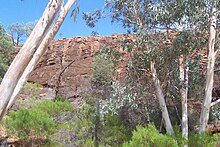Country
Wilyakali traditional lands covered an estimated 8,400 square miles (22,000 km2) from the Barrier Ranges westwards to Olary in South Australia. They encompassed Silverton, Mutooroo, and Boolcoomata. To the northwest they reached Mootwingee, and northeast to just south of Sturt Meadows. The tribe apparently moved south in the first half of the 19th century from its earlier domain to resist strong-arm cultural pressures from the Ngadjuri to adopt circumcision.
The Malyangapa lived on their northern tribal borders, while the Yardliyawara were to their west.
Native title
A native title claim covering thousands of square kilometres, including agricultural land as well as several small towns along the Barrier Highway, was lodged in 2012 by Maureen, Glen, and Dulcie O'Donnell, on behalf of the Wilyakali people. Native title was finally formally recognised on 28 August 2023, in a decision handed down by Justice Elizabeth Raper. [6] [7]
The Diyari, alternatively transcribed as Dieri, is an Indigenous Australian group of the South Australian desert originating in and around the delta of Cooper Creek to the east of Lake Eyre.

The Nauo language, also commonly written Nawu, is an extinct and little-recorded Australian Aboriginal language that was spoken by the Nauo people on the southern part of the Eyre Peninsula, South Australia. However, work on the reconstruction of the language by the Mobile Language Team at Adelaide University is proceeding.
Nukunu are an Aboriginal Australian people of South Australia, living around the Spencer Gulf area. In the years after British colonisation of South Australia, the area was developed to contain the cities of Port Pirie and Port Augusta.
The Mirning, also known as the Ngandatha, are an Aboriginal Australian people whose traditional lands lay on the coastal region of the Great Australian Bight extending from Western Australia into south-west South Australia.

The Paakantyi language, also spelt Paakantji, Barkindji, Barkandji, and Baagandji, and also known as the Darling language, is a nearly extinct Australian Aboriginal language spoken along the Darling River in New South Wales from present-day Bourke to Wentworth and including much of the back country around the Paroo River and Broken Hill. The people's and language name refers to the Paaka with the suffix -ntyi meaning "belonging to". The speakers of the language are known as the Paakantyi.
The Paakantyi, or Barkindji or Barkandji, are an Australian Aboriginal tribal group of the Darling River basin in Far West New South Wales, Australia.

The Muthi Muthi people are an indigenous Australian people whose traditional lands are located in the Northern Riverina and Far West regions of New South Wales.
Luise Anna Hercus, née Schwarzschild, was a German-born linguist who lived in Australia from 1954. After significant early work on Middle Indo-Aryan dialects (Prakrits) she had specialised in Australian Aboriginal languages since 1963, when she took it up as a hobby. Works authored or co-authored by her are influential, and often among the primary resource materials on many languages of Australia.
The Karieri people were an Indigenous Australian people of the Pilbara, who once lived around the coastal and inland area around and east of Port Hedland.

The Kureinji, otherwise known as the Keramin, are an Aboriginal group whose traditional lands are located in southwest New South Wales, Australia, along the north side of the Murray River roughly between today's settlements of Euston and Wentworth.

The Dadi Dadi or Tatitati are an Australian Aboriginal people whose traditional lands are located along the southern banks of the Murray River in Victoria Australia.
The Maraura or Marrawarra people are an Aboriginal group whose traditional lands are located in Far West New South Wales and South Australia, Australia.
The Barindji, also written Parrintyi, are an indigenous Australian people of the state of New South Wales. They are to be distinguished from the Paaruntyi, who spoke a similar language but whom they called the spitting people.
The Malyangaapa are an Indigenous Australian people who live in the far north western areas of the state of New South Wales.
The Ngurunta or Runda are believed to have been an indigenous Australian people of the state of South Australia located immediately west of Lake Frome.
The Naualko (Nhaawuparlku) were an indigenous Australian people of New South Wales.
The Jawi people, also spelt Djaui, Djawi, and other alternative spellings, are an Aboriginal Australian people of the Kimberley coast of Western Australia, who speak the Jawi dialect. They are sometimes grouped with the Bardi people and referred to as "Bardi Jawi", as the languages and culture are similar.

The Arabana, also known as the Ngarabana, are an Aboriginal Australian people of South Australia.
The Wangkangurru, also written Wongkanguru and Wangkanguru, are an Aboriginal Australian people of the Simpson Desert area in the state of South Australia. They also refer to themselves as Nharla.
The Wanjiwalku were an indigenous Australian people of the state of New South Wales.
This page is based on this
Wikipedia article Text is available under the
CC BY-SA 4.0 license; additional terms may apply.
Images, videos and audio are available under their respective licenses.













